25000 TAGS
Long March Project : Building Code Violations II
Location: Long March Space, Beijing (formerly known as 25000 Cultural Transmission Center)
Duration: Mar 1 – Apr 4, 2008
Artists: Chen Chieh-jen, Chen Jie, Chen Qiulin, He’an, Hong Hao, Huang Kuan&Wei Xuebing, Huang Kui, Hu Liu, Ingeborg Lüscher, Jiang Zhi, Jin Feng, Soni Kum, Li Chuan, Li Yong, Lisa Norton, Liu Wei, Qin Ga, Qiu Zhijie, Shao Yi, Shen Xiaomin, Shen Ye, Su Zhongqiu, Tang Maohong, Tang Yi, Wang Yigang, Wei Bingqiang, Xiao Xiong, Xu Zhen, Yang Guangnan, Yang Zhenzhong, Yu Ji, Zhang Ding, Zhang Liaoyuan, Zhang Qing, Zhou Xiaohu, Zhu Yu
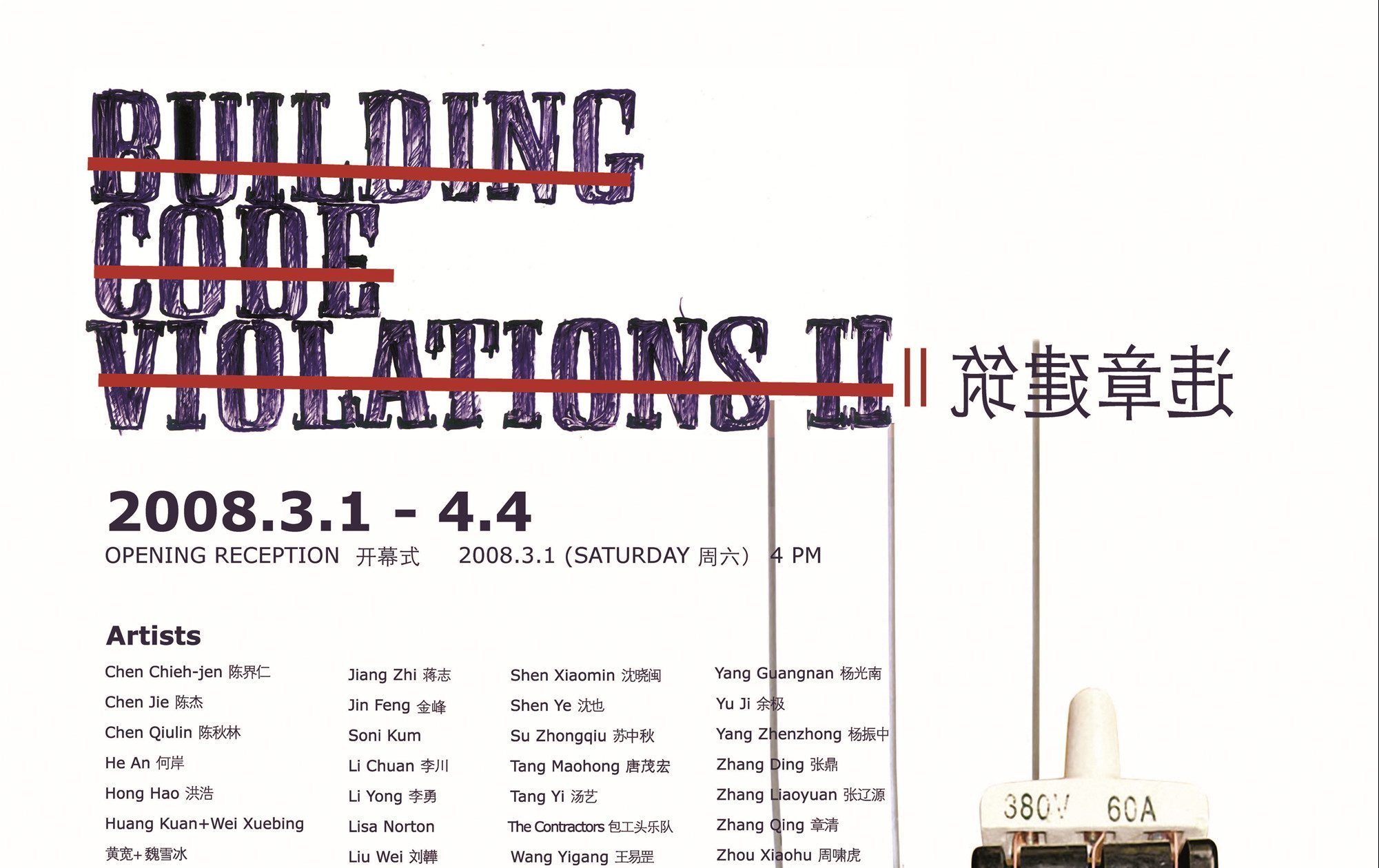
Long March Project : Building Code Violations II
‘Building Code Violations’ is a conceptual metaphor….
The concept of a “Building Code Violation” comes from the legal lexicon of modern urban planning and management, targeting those specific individual actions, which are in contravention of a normalized and unified social system. In this exhibition, “Building Code Violations” is a cultural approach directed at a “universal” modernity. This type of “top down” approach, while revolutionary in nature, has resulted in not only overturning local epistemological systems, but also a displacement of nature and space, a distortion of bodily experiences, and a heightening of class tensions. The expression of “violations” is built upon offshoots of individual needs, and underneath the surface of these acts resides a critique towards the construction of a particular idealist aesthetic or social construction.
The definition of a ‘Building Code Violation’ is officially classified a ‘fact’ in China, a breach of civil code. What is crucial to this understanding of a ‘building code violation’ is that what may be considered a violation one year, may be approved in the next. Building code violations, constructed in daily life should be understood as a natural process in the evolution of a society, rather than the basis for social statistics. Such violations can be formless, hidden or undetectable; it could be an individual experience or an unconscious collective perception accumulated in the process of an action. Are we “building” in response to a “violated code”? Or are we consciously “violating code” in response to the “building” around us. Such conundrums are at the heart of this project. This exhibition interprets the concept of “Building Code Violations” as a conflict between social reality and aesthetic ideals. It highlights the contradiction between globalization’s advancement of a single cultural value system, and the reality of societies whose functional systems of existence are thrown apart by its imposition.
The creation of a ‘building code violation’ responds to an existing situation that is deemed dysfunctional or inherently opportunistic in its approach to cultural, social, or political value – hence individuals seek to pose new methods of action and in turn propose new methods of existence. Consequently, “Building Code Violations” reflects the power of the “self-built” environment, it points to a necessary force motivated by local contexts, which cannot be overruled by global standards. The existence of such violations, in a cultural sense, demands that we ask what conditions brought about this breach of code; what circumstances drove an individual to take a situation into their own hands in an attempt to improve or adapt; why did this individual feel so compelled to act in this way? In other words, the shape of the ‘violation’ matters.
‘Building Code Violations will be an exhibition that presents a series of solutions which are in progress, created in response to the reality of social frameworks of today.
In this global world, there are numerous actions and creations that could be considered violations within the fabric of society and social behavior. These various violated codes possess the power to change what may be considered temporary circumstances into permanent and functional entities. This is a never-ending cycle of intervention and approval.
Everything is built in violated codes.
Installation View
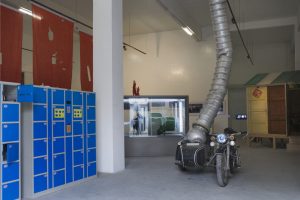
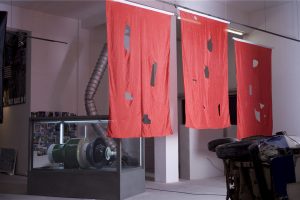
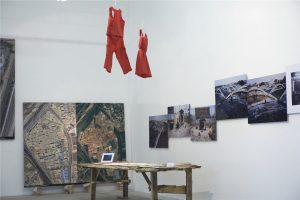
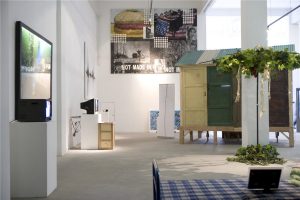
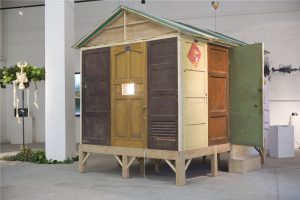
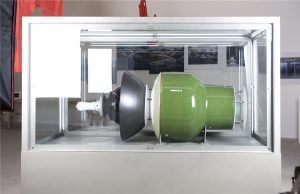
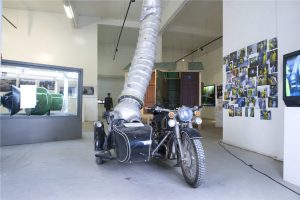
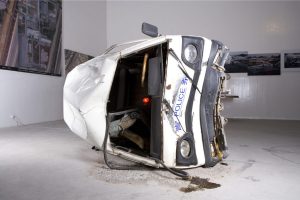
Chen Chieh-jen
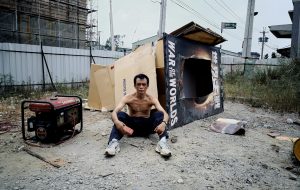
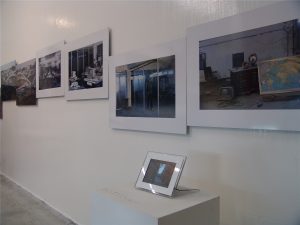
Chen Chieh-jen, Bade, Super 16mm transferred to DVD, color, silent, 30 minutes, Single-channel, continuous projection, 2005
Artist’s Statemet
The idea for this work began one day when I was strolling around the ‘area’ where I was filming, and I saw an unimposing billboard advertising a planned apartment complex. Often, these kinds of billboards will include virtual, computer-generated drawings, providing an imaginary, expansive and scenic image of the building as it is supposed to look when completed. But on this billboard appeared nothing except the words ‘The Majestic Town’ and an arrow pointing toward the site, along with a telephone number. I followed in the direction the arrow pointed, and found a big stretch of deserted land, where a factory had just been torn down, but no new project had yet begun.
Some residents I knew lived nearby, eking out a living as temporary laborers. They showed me around the area, where I discovered an abandoned office, inside of which computer equipment from 20 years ago had been left behind, as well as old-style computer disks that could no longer be read. The courts had sealed off this office. With the redistribution of labor brought about by the state of the global economy, the owners of some of the factories within the ‘area’ closed their plants without properly settling accounts, or operated them unscrupulously, and consequently the factories were constantly being resold, torn down or renovated. This made the “area” seem like a town pieced together like a collage that was never quite completed. And the people living in the area had no choice but to switch their line of work along with the shifting state of the economy.
In the film I invited friends, and the local residents who made a living as temp laborers to wander around the spaces that had been sealed off for auctioning. The narrative of the film did not center on presenting the beginning of end of any concrete event, but rather focused on the ‘behavioral process’ of these temp workers as they roamed the area of ‘The Majestic Town’.
These scenes reflect a ‘behavioural process’ in imitation of their daily lives and what they did for work. Likewise, the objects inside the building that were sealed off by the courts could not be moved, and in the film, we did nothing but constantly move their positions, without really moving them off-premises. For me, whether it was the ‘behavioural process’ of the temp workers or the way the objects could only be shifted around, again and again, it all seemed to be related to that arrow pointing the way on the billboard announcing ‘The Majestic Town’. The arrow seemed to point not toward the empty, derelict plot as it presently existed, nor to the ‘The Majestic Town’ that could not even be imagined, but rather to a space that had ‘lost the meaning of time’.
Chen Jie
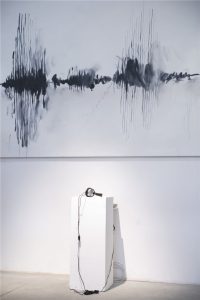
Chen Jie, Google Hot Word “What is Love?”, 2005
This painting and sound installation takes its inspiration from Google search engine’s most common enquiry beginning with the letter “w”: “What is love?”. Using a sound spectrograph taken from a computer read-out of the sentence, the artist transferred the image of the sentence onto canvas. Words, expressions, sound, imagery and the other emotions he wishes to express intertwine, affect, influence and exist together, blurring the boundaries of his work. According to the artist, apart from enjoyment experienced from blurring the established process of painting, it is the interplay revealed between imagery and words that is of most significance.
Chen Qiulin
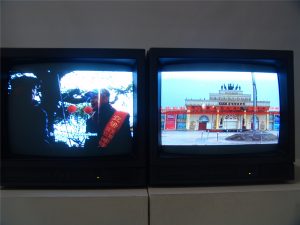
Chen Qiulin, About Xu Shaohua’s Dream, 2008
This work is divided into two images, and is about Xu Zhouhua, a farmer from Sichuan who for years has insisted on propagating the building of a spiritual civilisation. Chen Qiulin uses documentary form combined with a special topic television programme form, to produce an objective description of this “talented person’s” daily activities. The accompanying film shows the daily landscape of a modern city, its streets, public squares, commercial buildings and people going about their lives. Another aspect of the image is the line of subtitles that scroll across the screen, showing Xu Zhaohua’s constant propagation of a civilised society. On the day of Building Code Violation’s opening, the artist invited Xu Zhaohua to come to the exhibition space, so that the audience could once experience his teachings on civilisation. In the film, speaking the related social civilization content. Began the same day in the display, the artist also welcome to has displayed piece in leading character Xu Zhaohua the scene, has carried on a solid place civilized propaganda to the audience. In the image, the language, in the dialogue which the actual behavior three subtle relations composes, we saw the real character and the event occurrence condition which made the person to think deeply about.
Hong Hao
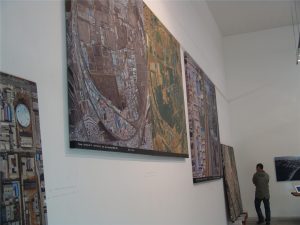
HongHao, 39°59’46.21″N 116°29’59.61″E, 2008
HongHao, 39°59’24.84″N 116°31’34.50″E, 2008
HongHao, 40°00’19.47″N 116°26’40.65″E, 2008
Hong Hao’s oil paintings are based on satellite mapping images found on Google Earth’s search of the 798, Caochangdi, Huantie and Jiuchang art districts. Through the process of switching between two image mediums, and from the perspective of building itself, the artist carefully examines the changes in how art looks at environment, and furthermore, invites us to contemplate whether or not the act of violation has become the creative force behind the development of contemporary art.
Huang Kuan + Wei Xuebing
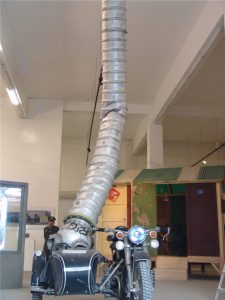
Huang Kuan & Wei Xuebing, CSP-TY1-1010, 2008
CSP-TY1-1010 is the code on the wreckage of China’s famous rocket “Lady in the Moon Number One”, that flew to the moon in 2005. In this collaborative work by Huan Kuan and Wei Xuebing, the wreckage of a rocket (measuring over four meters in length) has been craftily positioned above their own vintage side-car which is eerily secured to the ceiling in the gallery space. This authentic piece of rocket wreckage is a symbol of China’s power, and ought to be top-secret. By putting it together with a family vehicle in a public space, it breaks conventional thinking about “holy and inviolable national property”. The display of this rocket CSP-TY1-1010 is not merely concerning a violation, but rather a proposal of new definition that is construed by the viewer’s understanding of the challenging relationship between national property and public space.
Huang Kui
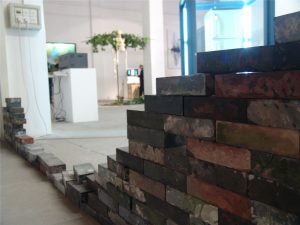
Huang Kui, Commemorating a Meaningless Forgotten Memory, 2008
Hu Liu
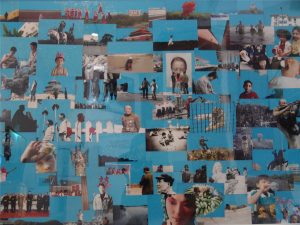
Hu Liu, 1982, Sky, 2008
Ingeborg Lüscher
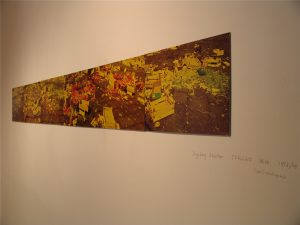
Ingeborg Lüscher, Torino, 1998/99
These photographs by Swiss artist, Ingeborg Luscher, were taken immediately after an open fresh-produce market had closed in a public plaza, in Torino, Italy. Titled after the name of this historical city, this suite of six images provides a panoramic view of hapless disregard for material waste. The lack of human presence in each image is an eerie suggestion of physical violence or a cataclysmic disaster. Fruit, vegetables, flowers, wooden baskets and cardboard boxes are strewn across the plaza floor, as if something has exploded. Luscher speaks of this series as possessing an ‘architectural atmosphere’, as if we are looking at ruins after battle. In registering this scene as a domestic, daily occurrence of greed, consumption and abundance, Ingeborg Luscher draws our attention to the lack of beginnings and endings in human behavior. The cleaning trucks moved in to remove this waste not long after Luscher took these photographs, preparing this public square for yet another market onslaught.
Jiang Zhi
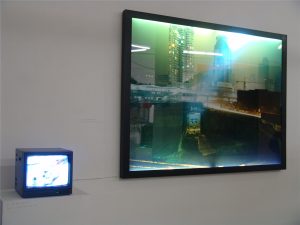
Things would turn nails once they happened, 2008
Things would turn nails once they happened, 2008
This body of work is based on the report on “..history’s most stubborn household resisting relocation..” that took place at the beginning of March 2007, on the Yang family land in Sichuan Province, China. The photograph shows rays of light shining on the household, an old two-storey red-brick house which sits, pillar-like, in a huge excavation pit several meters deep. The homes of their neighbors have been demolished, this pillar of defiance standing like an isolated island, alone in a huge abyss. This is the last photographic work in Jiang Zhi’s series “Bright Light”, and it is also the only image that documents an actual event. Ironically, in this image the rays of light press down on the scene almost as if you are observing a dream that has been paralyzed, producing an image of absurdity that is more fantastical than a fictional event. The video is documentary footage taken during a confrontational incident between the owners of this home and a group of media reporters covering the story. Mr and Mrs Wu Ping, are seen in heavy argument, angrily shouting their rights as citizens. This work highlights Jiang Zhi’s deep reflection of contemporary China and its increasing social problems, taken from behind the documentary lens.
金锋
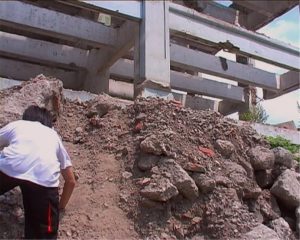
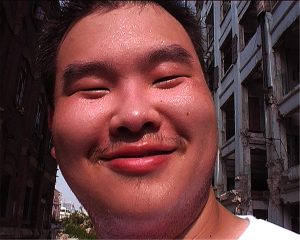
Jin Feng, New Land, 2008
Two teenagers drift listlessly in a deserted building estate in this single channel video. Employing the simple narrative structure of children’s storytelling, and using background music from children’s radio shows, these two teenagers maintain dead-pan facial expressions as they refer to each other as ‘king’ and ‘cabinet minister’, suggesting the ruins in which they play is their ‘kingdom’, their actions a game of ‘political affairs’. This work has strong metaphorical implications, juxtaposing the simple and humourous relationship between the two characters with the intrinsic absurdity of the complexity and seriousness of humanity’s systems of political authority, culture and history, transforming the huge superstructure of invisible “violations” into a cute theatrical model.
Soni Kum
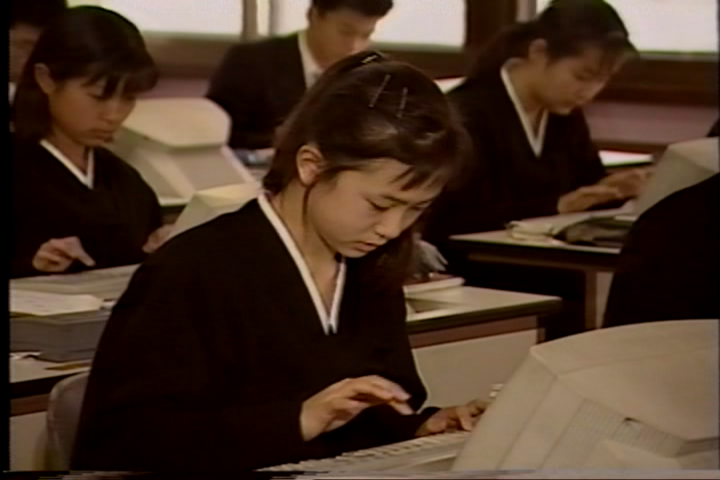
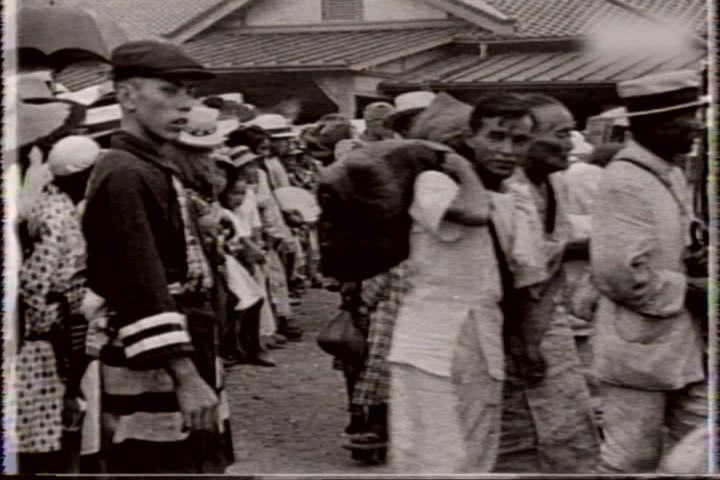
Soni Kum, The Foreign Sky, 2005
The artist comments on Foreign Sky: ‘After liberation from the Japanese, Koreans living in Japan had two choices of citizenships to take, North or South. 152,900 North Korean nationals now live in Japan as a direct consequence of Japanese colonialism. This story of the North Korean community is told by tracing my memory and family history. This film is a fiction based on actual historical events that consists of archival film and video footage. Memories are always in flux and recomposed constantly. This film is my own reflection of the past. The official historical record is never free from a ‘nation’.
Li Chuan
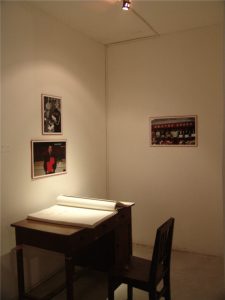
Li Chuan, Da Ning County Book, 2008
Li Yong
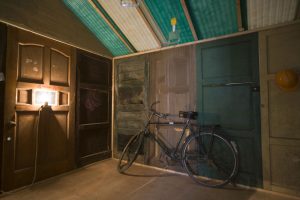
Li Yong, Sheng Li Road No. 90, 2008
This installation has incorporated old dismantled doors to make a small wooden house. Li Yong seeks to present the history and memories of the families who owned each door, emphasizing the varying environments from which each was taken (indicated by color, shape, design etc.). In the gallery space, this temporary house, constructed from the memories of many people, is filled with feelings of segregation and isolation, resembling a monument, an architectural celebration of human victory. Inside the house, a hard hat, warning light, and discarded sweet packets suggest a human presence; the postal service bicycle, bus handles and wind vane symbolizing an indeterminate and mobile existence. When homes are demolished and people forced to migrate, living areas are reconstructed again and again. In this process of re-building, memories become fragmented, piecemeal and exaggerated, highlighting a contradiction in the assumption of History as a linear tale. In this temporary living space, many different stories of the past connect and join as one.
Lisa Norton
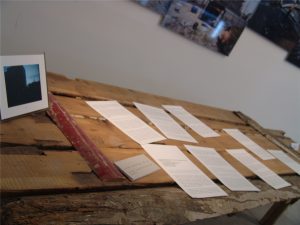
Lisa Norton, Systems for Slow(er) Structures, 2008
Lisa Norton is an Associate Professor at the School of the Art Institute in Chicago. In 2005, she initiated what has come to be known as Systems for Slow(er) Structures. This project is a trans-disciplinary research base for the production of community programs designed to function as ethical inquiries on the contested realm of sustainable development, specifically in post-colonial Asia. The programs and workshops under the umbrella of Systems for Slow(er) Structures also aim to develop transferable, exportable ideas that benefit people and generate livelihoods. Building on local knowledge and human capital networks, the program seeks to enable more viable local economies that address the pressures brought about by globalization, while maintaining sustainable scales of growth. The Systems for Slow(er) Structures program engages a long-term relationship with the community of Chongwu Township, the production centre for the stone industry in China, in order to develop a comprehensive environmental plan to ensure its material cultural resources continue into the future.
Liu Wei
 Liu Wei, Porcelain III, 2006
Liu Wei, Porcelain III, 2006
Porcelain III could be mistaken for a piece of military equipment; a component from a science and technology facility; or even that of a UFO. However, the work is actually a construction composed of porcelain products that we use on a daily basis. Our initial familiarity with these common porcelain products is challenged by the artist’s simple process of re-configuration, giving these everyday objects new meaning. The viewers’ judgment of this strange object as a whole is associated with their own collective imagination of use and function, highlighting the determination of value given in relation to visual recognition of a social need. Sitting within an enclosed glass case, the unique physical appearance of this work suggests a physical violation of a structural kind, as if the object contains a potent chemical or an unknown special status. Giving “Porcelain” as a general title indicating the object’s medium emphasizes a non-subjective judgment of the state of an object’s existence.
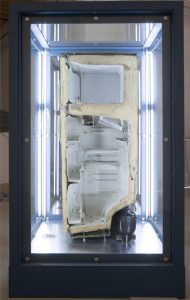 Liu Wei, You are Looking at What is Mine, 2006
Liu Wei, You are Looking at What is Mine, 2006
This installation is composed of a fridge that has been cut open, displaying only one segment so that the inside of the fridge can be seen. It sits inside a glass case with a Polaroid photograph resting inside on its base. You are looking at what is mine is part of a series of works based on the theme of ‘cutting’. The artist uses a Polaroid camera to take a picture of a part of an object, and then cuts the object so that it has the same composition as the photograph. Through this process, the artist is not just simply building a relationship between the object and the photograph, but challenges the original form of the object. This conceptual approach indicates a strong desire to transform and dissimilate objects, and is a derisive view of the problems brought about in contemporary society by property rights, urban materialism and questions of belonging to community.
Qin Ga

Qin Ga, Hamsters, 2008
15 “rats” that have been dyed white are spread out in a line along a wall that has been newly painted white. A rat hole has been gnawed into the bottom corner of the wall. The positioning of the rats suggests that they are happily running toward their “paradise”. Starting from Chinese New Year, Qin Ga uses rats as a medium, borrowing the symbol of the Year of the Rat from China’s lunar calendar. Within a white contemporary art museum space, this installation breaks the established conventions of display, thus becoming a “violation” itself. The work’s title “Hamsters” takes its inspiration from the title of a poem in The Book of Odes (the earliest known poetry anthology in China), called Hamsters. Hamsters speaks of the glorious ideal of building a “paradise”, seeking a society in which everyone is equal. Whilst the work expresses the exhibition’s “violation” motif, it also expresses the hopes of a “Utopian” society for the future that are held by today’s society in which you encounter “violations” everywhere you go.
Qiu Zhijie

Qiu Zhijie, Three Red Flags, 2008
 Qiu Zhijie, Yaodu Square, Linfen, Shanxi Province, 2007
Qiu Zhijie, Yaodu Square, Linfen, Shanxi Province, 2007
Qiu Zhijie, Huaxi County Huayin, Jiangsu Province, 2007
These two backlit photographs depict a scene that resembles the gate tower at Tiananmen Square in Beijing. In reality, these are two different buildings that appear in public spaces in China as symbols of authority. The artist places these two images side by side in order to reflect on the general function and appearance of Chinese architecture. For example, when white marble supports a magnificent building above it, local people do not need further explanation of this building’s character and use. Qiu Zhijie questions China’s national consciousness associated with these two images by photographing people wearing masks as they appear to be reading books on psychoanalysis. For Qiu Zhijie, people are the essential elements to the meaning and purpose of a country’s identity. In these works, Qiu highlights the important relationship between an individual and their surroundings in the construction of a national identity. Qiu asks, in the construction of a uniform system of visible authority, is it possible that contemporary society have lost the ability to understand its symbol of power, referring to them as mere tourist attractions or icons of the past?
Shao Yi
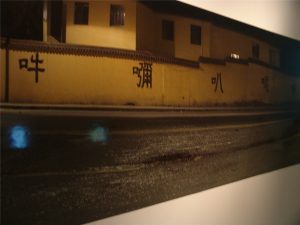
Shao Yi, Vestige No.1, 2008
The work records a common highway scene in which evidence of a car accident or an accident where animal has been hit, such as bloodstains or broken glass, has been visibly left on the road. This work is the start of a series of works about traces of various events or activities that are left behind and are encountered in everyday life. The series is an ongoing conscious recording of these everyday encounters.
A temple’s yellow outer wall makes up the background of the photograph, on which is written a Buddhist scripture. The spiritual and peaceful aspects of the temple are juxtasposed with the traces left on the road, creating the sense of departure and hurt that pervades this scene.
Shen Xiaomin
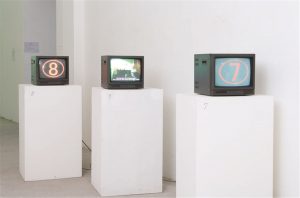
Shen Xiaomin, “7″”9″”8″, 2002-2008
“7” “9” “8” is a three-channel video work that documents the little-known conflicts of Beijing’s 798 Art District. Taking six years to complete, this series of discussions provides historical record in representing the 3 different communities within 798: the galleries, the artists and the 798 management team. Taking place in Asia’s largest contemporary art community, this film documents and manufactures the relationships between these three groups, showing the complex intertwining of mutual rejection, dependence and restriction between these groups. The current stability of this art community is built on the conflicts and transformations of past interests, but who can guarantee that someday this stability will not be put under pressure by other acts of violation?
Shen Ye
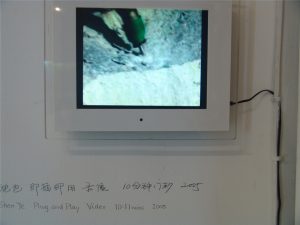
Plug and Play, 2005
The work borrows the number 108 from the 108 characters in the Chinese literature classic The Water Margin. The work gathers together 108 images of actions of plugging in and out that we do in our day to day lives. In under 10 minutes, all the footage flashes across the screen in fast forward. The way in which the work is created is both humourous and colourful, but it has further implications – from the background of modern material civilsation, we can see that humanity’s increasing material desires are becoming more and more similar to animal instincts.
Su Zhongqiu
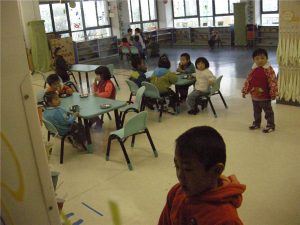
Su Zhongqiu, Children’s Education White Book, 2008
Su Zhongqiu is a lecturer at the Xian Art Academy, and for many years has been concerned with the state of education for children in China.
2008
Children’s Education White Book is a video that explains the artist’s opinions on children’s education, and is accompanied by a pamphlet of text, edited by the artist, containing related articles on education in China.
2008
Keeping abreast of international developments and theories regarding children’s education via the Internet, Su Zhongqiu references particular aspects of Western methodologies in pre-school curriculums, discussing the benefits of process based exercises in the development of a child’s creative imagination. The actions of an individual becoming involved in a social system (such as education), and initiating and implementing changes within the system (without official approval) can be viewed as a kind of ‘ building code violation’.
2008
“The white book is a governmental or official style document, but seeing as they don’t take action or are inefficient, the only way we can get involved is by way of discourse amongst the people.” – Su Zhongqiu
Tang Maohong
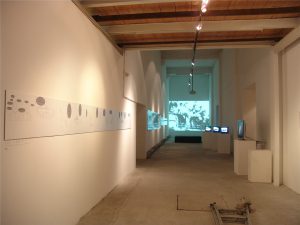
Tang Maohong, Bad Guy Tang Maohong, 2008
n/a
Tang Yi
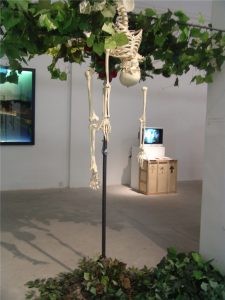
Tang Yi, Between the Disaster and Constructions, 2008
Tang Yi takes a light tone in hanging a pure-white human skeleton upside down amidst foliage, creating a heavy sense of discord contradiction within the space, and refering to how in real life, things are often bipolar. The artist explains, “when people are really hot, they cannot imagine what it is like to be freezing, and vice versa; when you are excited about building something, you cannot imagine that it could be a disaster, and when you meet a disaster, you cannot imagine anything.”
Wang Yigang
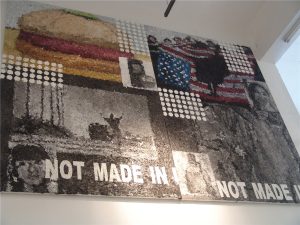
Wang Yigang, It’s not made in the USA, 2007
This work is a part of Wang Yigang’s Made in America series. Melding together real images with his own creations, the multi-layered imagery of Wang Yigang’s canvases blur the viewer’s conceptions of reality and imagination. Employing bold, well-known symbols such as the American flag and a hamburger to sybolise America, as well as imagery from the war in Iraq, the work expresses the artist’s criticism of America, and emphasises his humanitarian stance, taking his artwork to previously unseen levels of intensity. Wang Yigang often says that the artist community is a disadvantaged one, and that they cannot change anything. But taking their real life experiences and concerns, artists can use colour to voice their opinion through their artwork. This is the social responsibility that artists should shoulder.
Wei Bingqiang
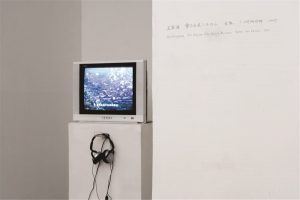
Wei Bingqiang, Huo Zhiyuan at Non-belonging Mountain, 2007
“When I saw Non-belonging Mountain, I immediately knew, I would give my life to this mountain, this mountain is my ideal kingdom!”
taken from the online diary Non-belonging Mountain – Huo Zhiyuan’s Ideal Nation.
The work Huo Zhiyuan at Non-belonging Mountain is a record of a real person and real events. The film is shot at Non-belonging Mountain, in Qufu, Shandong Province, and records the mountain’s caretaker, Huo Zhiyuan, reading aloud from his diary. The film has an air of detachment, recalling a common scene from ancient China where a person slowly wanders through his garden, reciting poetry in a slow rhythm, isolated from the outside world and frozen in time. Huo Zhiyuan retreated to the countryside from an urban, materialistic life in order to cultivate a closer relationship to nature. His diary spouts his reflections, concerns and opinions of contemporary society. The isolation of this event and the detachment of context for his spoken words could perhaps be seen as a violation of these lofty surroundings.
Xiao Xiong

Xiao Xiong, Crashed, 2008
Xiao Xiong transforms a police minivan, beating it into its current mutated form. Like a witness to a major traffic accident, the viewer is forced to remember they are standing in an art gallery, the exterior and interior of this vehicle seriously injured, its body in an unending wail as its siren continually flashes, begging the viewer to ponder the relationship between sensitive political issues and potentially imagined media. As the title Bumped Into and its dramatic context suggest, this work refers to contradictions between social realities and value systems of authority. As a work in Building Code Violations II, the artist humorously refers to the understanding of this vehicle as an object of power, seeking to reverse the terminology in judging how a “violation” can be defined.
Xu Zhen
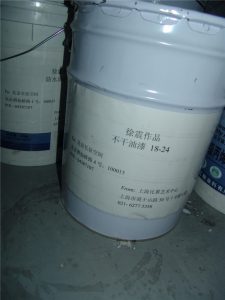
Xu Zhen, Untitled, 2008
Xu Zhen’s installation entitled “Untitled” is made up of an exhibition wall that has been coated in a thick, gluey white paint that never dries. The work itself has no pattern or visible element, so that the viewer cannot tell that the seemingly normal wall is itself a work. Within the exhibition space, the wall can be used as a normal exhibition wall, in that other artists can use this “special” wall to display their work. This will also help in concealing the work, as most viewers will only notice the works hung on the wall, not the wall itself. It is only when they are being careless that they will suddenly notice thick white paint stuck to their clothes, will question why, and will look at the wall from a fresh perspective, finally seeing the possibilities of “harm” that is undoubtedly a part of the work. In a light, prank-playing style, the viewer is forced to participate in the the work and within the space, where the work concretizes and brings significance to its wide-ranging metaphors of “invisibility”.
Yang Guangnan
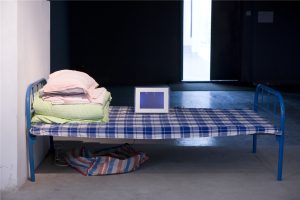
Yang Guangnan, Miao Miao, 2008
Miao Miao attempts to illustrate the marked difference between office life and domestic living quarters in contemporary urban life. The installation is composed of a simple bed frame and bedding belonging to Miao Miao (the artist’s friend), her tale told on a small monitor, which rests on her bed in the exhibition space. Although Miao Miao works in a luxury office building, the quality of her personal life is in stark contrast, with its simple and crude furniture, its blue and white checked bedding that she has owned since being a student at university. The influx of workers from regional areas of China to Beijing has become a significant social phenomenon in recent years, the rapid modernization of China’s economy forcing countless numbers of rural people to find employment in city centers. This installation explores the conditions of one of these workers, calling for deeper introspection on the imbalance of everyday life, between the quality of private space and working environments, calling into question the effect this situation has on an individual’s state of being. The unknown dream that Miao Miao blindly chases in the short video reflects a psychological attribution of this violation of human nature.
Yang Zhenzhong
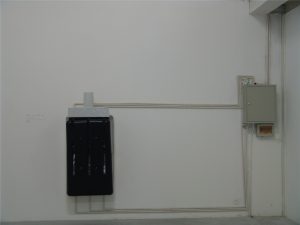
Yang Zhenzhong, Long March General Electric Circuit Breaker, 2008
Yang Zhenzhong takes a common electrical switch and enlarges it to life-size. It is displayed next to the actual electrical switch, and is engineered so that it is connected with the power source so that it can be used as an actual electrical switch. If a curious viewer pulls the switch, it will cut the power of part of the exhibition space (including the lights and the projection equipment), and once it is switched back, everything will go back to normal. On the surface this installation is light and funny, allowing the viewer to interact with the exhibition space. However, the work carries serious undertones of social criticism, looking at the system of authority.
Yu Ji
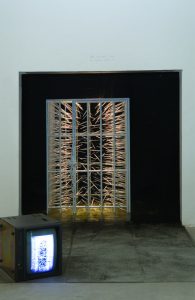
Yu Ji, Water Prison, 2008
This work takes a white cage as its subject, lying at the bottom of an enclosed, narrow square space, which appears to rest beneath a never-ending flow of water. The cage is composed of spikes, which are crowded together, pointing towards the cage’s center. A small monitor rests in front of this well of water, showing a man wearing a western business suit who appears caught in the center of this cage, struggling to avoid the pointed, jagged spikes. The cage symbolizes an underwater torture chamber, the spikes representative of a piercing of the self — a self-awakening. This work questions modern society in which modern man changes and struggles through self-imprisonment and self-reflection in an enclosed space of their own making.
Zhang Ding
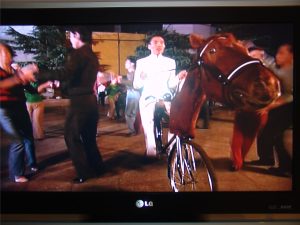
Zhang Ding, Da Shi Dai, 2007
Da Shi Dai tells the tale of a journey through a dream. The dream begins with the raising of a red curtain and a man dressed in a white suit appears as he discovers a bicycle with a horse’s head attached. In this work, Shanghai provides a theatrical stage for this male protagonist as he rides his horse-bicycle through a landscape surreally void of people, his calm perusal of the city accompanied by electronic music that was fashionable in Shanghai during the 1980s. Although these public spaces and characters coexist, they do not interact. It is as if two parallel worlds inhabit the same space, transmitting an unconscious and illogical state of being. This work uses the element of light to give the impression of a computer game, this ‘dreamscape’ rendered almost two-dimensional, emphasizing the scenery as staged, despite the physical existence of these places. This allusion to an interactive image is a deliberate ploy on the part of the artist who desires the viewer to be drawn subconsciously into the plot of the story, making them a part of his dream journey.
Zhang Liaoyuan
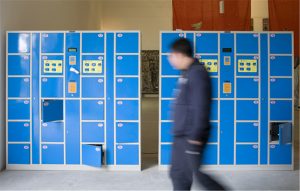
Zhang Liaoyuan, Open, 2008
Open is composed of a self-service storage unit often found in public shops and markets, however this particular storage device is disconnected from manual operation, a machine set to an automatic command where doors seemingly open and close to their own choosing. As a machine produced by man, that has the ability to self-operate, does it make man think about whether the creations of a materialistic society someday could make humanity fall into debt? After altering a ready-made object from the marketplace and displaying it as a work of art, the piece becomes a prediction for the future in a modern commercial and social context.
Zhang Qing
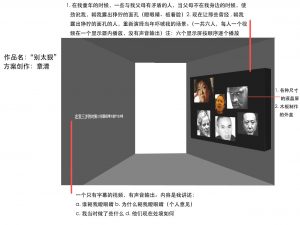
Zhang Qing, Don’t be too bad, 2008
In this two-channel installation, Zhang Qing narrates his past and present experiences with several relatives and neighbors whom he felt always glowered at him as a child. The work combines the artist’s memories as monologue, the various characters in this piece representing his relatives and friends, their gaze directed at the camera, as if challenging the artists’ personal recollections. In reality Zhang Qing has reconciled his childhood grievances with the people referenced in this work. Don’t be too bad is a re-tracing of an individual’s own history and past memory – is his recollection of pain from these experiences as acute as when he first felt their disapproving glare? With the lapse of time, these “Don’t be too bad” emotions can be seen as a sort of building code violation of the psyche.
Zhou Xiaohu
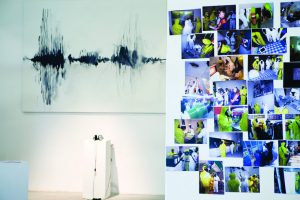
Zhou Xiaohu, Environment Test, 2008
Environmental Test is an on-site performance piece which was realised at the opening of Building Code Violations II. Inspectors from the Beijing Environmental Monitoring Bureau tested every work in Building Code Violations II on-site for elements of pollution, such as traces of formaldehyde, percentages of volatile matter, levels of electromagnetic radiation, and high noise levels. Following the improvement in quality of contemporary society, people have become increasingly sensitive to the word “pollution”. Zhou Xiaohu humourously places this ‘worry’ within an art space, questioning whether art is also a form of pollution. This extends into a series of questions: Is art pollution abstract or physical? In viewing art, what psychologoical precautions and attitudes should the viewer take? Environmental Test uses an absurd and exaggerated performance to show how free will is in decline, increasingly falling foul of paranoia, in an extremely materialistic era.
Film documentation, a test report and photographic documentation of Environment Test are displayed in the exhibition space.
Zhu Yu
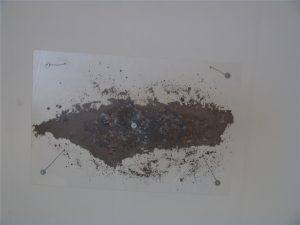
Zhu Yu, Small Heaven, 2008
Zhu Yu tied explosives to the corpse of a sheep and blew it up into tiny parts. During the process, the wreckage of the sheep mixed with mud from the ground. The artist took this mixture and spread it on a pane of Plexiglas in the shape of a map of Palestine and Israel, which he subsequently hung from the ceiling in the gallery space. This work asks the viewer to contemplate the relationship between suicide bombing and the political situation of war in the Middle East. Furthermore, the title Small Heaven suggests an association of death with religion, questioning what happens after the passing of life. Small Heaven is also the name of a place in Beijing, which brings in an aspect of mockery WHAT KIND OF PLACE IS SMALL HEAVEN, NEED TO DESCRIBE WHY IT IS A MOCKERY. These subjects are rich in metaphor; making connections between physiological, psychological, political and religious aspects of contemporary society. Dependent on cultural perspective and moral attitude, such a work, made from such materials, could be considered an insensitive “violation” of
The Contractors
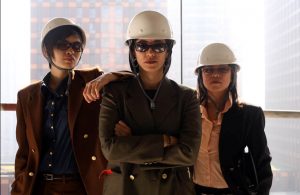
The Contractors, 《Super Complex-City Phase I:Hands-Free Strategy for Creative Business Practicing》, 2008
The Contractors is an ongoing multi-disciplinary project that explores the modern myth of Chinese urbanization and construction culture through performances, new media projects and information rendering. An irreverent take on the runaway capitalist economy within China, we intend to draw parallels between rampant urban development and the current unbridled international market for contemporary Chinese art. Previous projects-performances of power point presentations, fake media interviews, and impromptu interventions in art world events seek to re-position notions of ‘success’ and ‘achievement’ alongside issues of production and questionable business practices within the two overlapping worlds of art and property investment.
The Contractors is comprised of multi-disciplinary and multi-cultural artists/writers/curators/construction workers from the USA and China. Conceived in 2006, The Contractors consist of three members: Rania Ho, Wei Weng and Pauline Yao. The group has organized interventions in printed magazines, art fairs and performance festivals, performed in nightclubs and has a formative online following. They also have a hand in the fabrication of high-rise skyscrapers and highway overpasses. The band is currently based in Beijing, China. They accept most bribes.

Long March Project : Building Code Violations II
‘Building Code Violations’ is a conceptual metaphor….
The concept of a “Building Code Violation” comes from the legal lexicon of modern urban planning and management, targeting those specific individual actions, which are in contravention of a normalized and unified social system. In this exhibition, “Building Code Violations” is a cultural approach directed at a “universal” modernity. This type of “top down” approach, while revolutionary in nature, has resulted in not only overturning local epistemological systems, but also a displacement of nature and space, a distortion of bodily experiences, and a heightening of class tensions. The expression of “violations” is built upon offshoots of individual needs, and underneath the surface of these acts resides a critique towards the construction of a particular idealist aesthetic or social construction.
The definition of a ‘Building Code Violation’ is officially classified a ‘fact’ in China, a breach of civil code. What is crucial to this understanding of a ‘building code violation’ is that what may be considered a violation one year, may be approved in the next. Building code violations, constructed in daily life should be understood as a natural process in the evolution of a society, rather than the basis for social statistics. Such violations can be formless, hidden or undetectable; it could be an individual experience or an unconscious collective perception accumulated in the process of an action. Are we “building” in response to a “violated code”? Or are we consciously “violating code” in response to the “building” around us. Such conundrums are at the heart of this project. This exhibition interprets the concept of “Building Code Violations” as a conflict between social reality and aesthetic ideals. It highlights the contradiction between globalization’s advancement of a single cultural value system, and the reality of societies whose functional systems of existence are thrown apart by its imposition.
The creation of a ‘building code violation’ responds to an existing situation that is deemed dysfunctional or inherently opportunistic in its approach to cultural, social, or political value – hence individuals seek to pose new methods of action and in turn propose new methods of existence. Consequently, “Building Code Violations” reflects the power of the “self-built” environment, it points to a necessary force motivated by local contexts, which cannot be overruled by global standards. The existence of such violations, in a cultural sense, demands that we ask what conditions brought about this breach of code; what circumstances drove an individual to take a situation into their own hands in an attempt to improve or adapt; why did this individual feel so compelled to act in this way? In other words, the shape of the ‘violation’ matters.
‘Building Code Violations will be an exhibition that presents a series of solutions which are in progress, created in response to the reality of social frameworks of today.
In this global world, there are numerous actions and creations that could be considered violations within the fabric of society and social behavior. These various violated codes possess the power to change what may be considered temporary circumstances into permanent and functional entities. This is a never-ending cycle of intervention and approval.
Everything is built in violated codes.
Installation View








Chen Chieh-jen


Chen Chieh-jen, Bade, Super 16mm transferred to DVD, color, silent, 30 minutes, Single-channel, continuous projection, 2005
Artist’s Statemet
The idea for this work began one day when I was strolling around the ‘area’ where I was filming, and I saw an unimposing billboard advertising a planned apartment complex. Often, these kinds of billboards will include virtual, computer-generated drawings, providing an imaginary, expansive and scenic image of the building as it is supposed to look when completed. But on this billboard appeared nothing except the words ‘The Majestic Town’ and an arrow pointing toward the site, along with a telephone number. I followed in the direction the arrow pointed, and found a big stretch of deserted land, where a factory had just been torn down, but no new project had yet begun.
Some residents I knew lived nearby, eking out a living as temporary laborers. They showed me around the area, where I discovered an abandoned office, inside of which computer equipment from 20 years ago had been left behind, as well as old-style computer disks that could no longer be read. The courts had sealed off this office. With the redistribution of labor brought about by the state of the global economy, the owners of some of the factories within the ‘area’ closed their plants without properly settling accounts, or operated them unscrupulously, and consequently the factories were constantly being resold, torn down or renovated. This made the “area” seem like a town pieced together like a collage that was never quite completed. And the people living in the area had no choice but to switch their line of work along with the shifting state of the economy.
In the film I invited friends, and the local residents who made a living as temp laborers to wander around the spaces that had been sealed off for auctioning. The narrative of the film did not center on presenting the beginning of end of any concrete event, but rather focused on the ‘behavioral process’ of these temp workers as they roamed the area of ‘The Majestic Town’.
These scenes reflect a ‘behavioural process’ in imitation of their daily lives and what they did for work. Likewise, the objects inside the building that were sealed off by the courts could not be moved, and in the film, we did nothing but constantly move their positions, without really moving them off-premises. For me, whether it was the ‘behavioural process’ of the temp workers or the way the objects could only be shifted around, again and again, it all seemed to be related to that arrow pointing the way on the billboard announcing ‘The Majestic Town’. The arrow seemed to point not toward the empty, derelict plot as it presently existed, nor to the ‘The Majestic Town’ that could not even be imagined, but rather to a space that had ‘lost the meaning of time’.
Chen Jie

Chen Jie, Google Hot Word “What is Love?”, 2005
This painting and sound installation takes its inspiration from Google search engine’s most common enquiry beginning with the letter “w”: “What is love?”. Using a sound spectrograph taken from a computer read-out of the sentence, the artist transferred the image of the sentence onto canvas. Words, expressions, sound, imagery and the other emotions he wishes to express intertwine, affect, influence and exist together, blurring the boundaries of his work. According to the artist, apart from enjoyment experienced from blurring the established process of painting, it is the interplay revealed between imagery and words that is of most significance.
Chen Qiulin

Chen Qiulin, About Xu Shaohua’s Dream, 2008
This work is divided into two images, and is about Xu Zhouhua, a farmer from Sichuan who for years has insisted on propagating the building of a spiritual civilisation. Chen Qiulin uses documentary form combined with a special topic television programme form, to produce an objective description of this “talented person’s” daily activities. The accompanying film shows the daily landscape of a modern city, its streets, public squares, commercial buildings and people going about their lives. Another aspect of the image is the line of subtitles that scroll across the screen, showing Xu Zhaohua’s constant propagation of a civilised society. On the day of Building Code Violation’s opening, the artist invited Xu Zhaohua to come to the exhibition space, so that the audience could once experience his teachings on civilisation. In the film, speaking the related social civilization content. Began the same day in the display, the artist also welcome to has displayed piece in leading character Xu Zhaohua the scene, has carried on a solid place civilized propaganda to the audience. In the image, the language, in the dialogue which the actual behavior three subtle relations composes, we saw the real character and the event occurrence condition which made the person to think deeply about.
Hong Hao

HongHao, 39°59’46.21″N 116°29’59.61″E, 2008
HongHao, 39°59’24.84″N 116°31’34.50″E, 2008
HongHao, 40°00’19.47″N 116°26’40.65″E, 2008
Hong Hao’s oil paintings are based on satellite mapping images found on Google Earth’s search of the 798, Caochangdi, Huantie and Jiuchang art districts. Through the process of switching between two image mediums, and from the perspective of building itself, the artist carefully examines the changes in how art looks at environment, and furthermore, invites us to contemplate whether or not the act of violation has become the creative force behind the development of contemporary art.
Huang Kuan + Wei Xuebing

Huang Kuan & Wei Xuebing, CSP-TY1-1010, 2008
CSP-TY1-1010 is the code on the wreckage of China’s famous rocket “Lady in the Moon Number One”, that flew to the moon in 2005. In this collaborative work by Huan Kuan and Wei Xuebing, the wreckage of a rocket (measuring over four meters in length) has been craftily positioned above their own vintage side-car which is eerily secured to the ceiling in the gallery space. This authentic piece of rocket wreckage is a symbol of China’s power, and ought to be top-secret. By putting it together with a family vehicle in a public space, it breaks conventional thinking about “holy and inviolable national property”. The display of this rocket CSP-TY1-1010 is not merely concerning a violation, but rather a proposal of new definition that is construed by the viewer’s understanding of the challenging relationship between national property and public space.
Huang Kui

Huang Kui, Commemorating a Meaningless Forgotten Memory, 2008
Hu Liu

Hu Liu, 1982, Sky, 2008
Ingeborg Lüscher

Ingeborg Lüscher, Torino, 1998/99
These photographs by Swiss artist, Ingeborg Luscher, were taken immediately after an open fresh-produce market had closed in a public plaza, in Torino, Italy. Titled after the name of this historical city, this suite of six images provides a panoramic view of hapless disregard for material waste. The lack of human presence in each image is an eerie suggestion of physical violence or a cataclysmic disaster. Fruit, vegetables, flowers, wooden baskets and cardboard boxes are strewn across the plaza floor, as if something has exploded. Luscher speaks of this series as possessing an ‘architectural atmosphere’, as if we are looking at ruins after battle. In registering this scene as a domestic, daily occurrence of greed, consumption and abundance, Ingeborg Luscher draws our attention to the lack of beginnings and endings in human behavior. The cleaning trucks moved in to remove this waste not long after Luscher took these photographs, preparing this public square for yet another market onslaught.
Jiang Zhi

Things would turn nails once they happened, 2008
Things would turn nails once they happened, 2008
This body of work is based on the report on “..history’s most stubborn household resisting relocation..” that took place at the beginning of March 2007, on the Yang family land in Sichuan Province, China. The photograph shows rays of light shining on the household, an old two-storey red-brick house which sits, pillar-like, in a huge excavation pit several meters deep. The homes of their neighbors have been demolished, this pillar of defiance standing like an isolated island, alone in a huge abyss. This is the last photographic work in Jiang Zhi’s series “Bright Light”, and it is also the only image that documents an actual event. Ironically, in this image the rays of light press down on the scene almost as if you are observing a dream that has been paralyzed, producing an image of absurdity that is more fantastical than a fictional event. The video is documentary footage taken during a confrontational incident between the owners of this home and a group of media reporters covering the story. Mr and Mrs Wu Ping, are seen in heavy argument, angrily shouting their rights as citizens. This work highlights Jiang Zhi’s deep reflection of contemporary China and its increasing social problems, taken from behind the documentary lens.
金锋


Jin Feng, New Land, 2008
Two teenagers drift listlessly in a deserted building estate in this single channel video. Employing the simple narrative structure of children’s storytelling, and using background music from children’s radio shows, these two teenagers maintain dead-pan facial expressions as they refer to each other as ‘king’ and ‘cabinet minister’, suggesting the ruins in which they play is their ‘kingdom’, their actions a game of ‘political affairs’. This work has strong metaphorical implications, juxtaposing the simple and humourous relationship between the two characters with the intrinsic absurdity of the complexity and seriousness of humanity’s systems of political authority, culture and history, transforming the huge superstructure of invisible “violations” into a cute theatrical model.
Soni Kum


Soni Kum, The Foreign Sky, 2005
The artist comments on Foreign Sky: ‘After liberation from the Japanese, Koreans living in Japan had two choices of citizenships to take, North or South. 152,900 North Korean nationals now live in Japan as a direct consequence of Japanese colonialism. This story of the North Korean community is told by tracing my memory and family history. This film is a fiction based on actual historical events that consists of archival film and video footage. Memories are always in flux and recomposed constantly. This film is my own reflection of the past. The official historical record is never free from a ‘nation’.
Li Chuan

Li Chuan, Da Ning County Book, 2008
Li Yong

Li Yong, Sheng Li Road No. 90, 2008
This installation has incorporated old dismantled doors to make a small wooden house. Li Yong seeks to present the history and memories of the families who owned each door, emphasizing the varying environments from which each was taken (indicated by color, shape, design etc.). In the gallery space, this temporary house, constructed from the memories of many people, is filled with feelings of segregation and isolation, resembling a monument, an architectural celebration of human victory. Inside the house, a hard hat, warning light, and discarded sweet packets suggest a human presence; the postal service bicycle, bus handles and wind vane symbolizing an indeterminate and mobile existence. When homes are demolished and people forced to migrate, living areas are reconstructed again and again. In this process of re-building, memories become fragmented, piecemeal and exaggerated, highlighting a contradiction in the assumption of History as a linear tale. In this temporary living space, many different stories of the past connect and join as one.
Lisa Norton

Lisa Norton, Systems for Slow(er) Structures, 2008
Lisa Norton is an Associate Professor at the School of the Art Institute in Chicago. In 2005, she initiated what has come to be known as Systems for Slow(er) Structures. This project is a trans-disciplinary research base for the production of community programs designed to function as ethical inquiries on the contested realm of sustainable development, specifically in post-colonial Asia. The programs and workshops under the umbrella of Systems for Slow(er) Structures also aim to develop transferable, exportable ideas that benefit people and generate livelihoods. Building on local knowledge and human capital networks, the program seeks to enable more viable local economies that address the pressures brought about by globalization, while maintaining sustainable scales of growth. The Systems for Slow(er) Structures program engages a long-term relationship with the community of Chongwu Township, the production centre for the stone industry in China, in order to develop a comprehensive environmental plan to ensure its material cultural resources continue into the future.
Liu Wei
 Liu Wei, Porcelain III, 2006
Liu Wei, Porcelain III, 2006
Porcelain III could be mistaken for a piece of military equipment; a component from a science and technology facility; or even that of a UFO. However, the work is actually a construction composed of porcelain products that we use on a daily basis. Our initial familiarity with these common porcelain products is challenged by the artist’s simple process of re-configuration, giving these everyday objects new meaning. The viewers’ judgment of this strange object as a whole is associated with their own collective imagination of use and function, highlighting the determination of value given in relation to visual recognition of a social need. Sitting within an enclosed glass case, the unique physical appearance of this work suggests a physical violation of a structural kind, as if the object contains a potent chemical or an unknown special status. Giving “Porcelain” as a general title indicating the object’s medium emphasizes a non-subjective judgment of the state of an object’s existence.
 Liu Wei, You are Looking at What is Mine, 2006
Liu Wei, You are Looking at What is Mine, 2006
This installation is composed of a fridge that has been cut open, displaying only one segment so that the inside of the fridge can be seen. It sits inside a glass case with a Polaroid photograph resting inside on its base. You are looking at what is mine is part of a series of works based on the theme of ‘cutting’. The artist uses a Polaroid camera to take a picture of a part of an object, and then cuts the object so that it has the same composition as the photograph. Through this process, the artist is not just simply building a relationship between the object and the photograph, but challenges the original form of the object. This conceptual approach indicates a strong desire to transform and dissimilate objects, and is a derisive view of the problems brought about in contemporary society by property rights, urban materialism and questions of belonging to community.
Qin Ga

Qin Ga, Hamsters, 2008
15 “rats” that have been dyed white are spread out in a line along a wall that has been newly painted white. A rat hole has been gnawed into the bottom corner of the wall. The positioning of the rats suggests that they are happily running toward their “paradise”. Starting from Chinese New Year, Qin Ga uses rats as a medium, borrowing the symbol of the Year of the Rat from China’s lunar calendar. Within a white contemporary art museum space, this installation breaks the established conventions of display, thus becoming a “violation” itself. The work’s title “Hamsters” takes its inspiration from the title of a poem in The Book of Odes (the earliest known poetry anthology in China), called Hamsters. Hamsters speaks of the glorious ideal of building a “paradise”, seeking a society in which everyone is equal. Whilst the work expresses the exhibition’s “violation” motif, it also expresses the hopes of a “Utopian” society for the future that are held by today’s society in which you encounter “violations” everywhere you go.
Qiu Zhijie

Qiu Zhijie, Three Red Flags, 2008
 Qiu Zhijie, Yaodu Square, Linfen, Shanxi Province, 2007
Qiu Zhijie, Yaodu Square, Linfen, Shanxi Province, 2007
Qiu Zhijie, Huaxi County Huayin, Jiangsu Province, 2007
These two backlit photographs depict a scene that resembles the gate tower at Tiananmen Square in Beijing. In reality, these are two different buildings that appear in public spaces in China as symbols of authority. The artist places these two images side by side in order to reflect on the general function and appearance of Chinese architecture. For example, when white marble supports a magnificent building above it, local people do not need further explanation of this building’s character and use. Qiu Zhijie questions China’s national consciousness associated with these two images by photographing people wearing masks as they appear to be reading books on psychoanalysis. For Qiu Zhijie, people are the essential elements to the meaning and purpose of a country’s identity. In these works, Qiu highlights the important relationship between an individual and their surroundings in the construction of a national identity. Qiu asks, in the construction of a uniform system of visible authority, is it possible that contemporary society have lost the ability to understand its symbol of power, referring to them as mere tourist attractions or icons of the past?
Shao Yi

Shao Yi, Vestige No.1, 2008
The work records a common highway scene in which evidence of a car accident or an accident where animal has been hit, such as bloodstains or broken glass, has been visibly left on the road. This work is the start of a series of works about traces of various events or activities that are left behind and are encountered in everyday life. The series is an ongoing conscious recording of these everyday encounters.
A temple’s yellow outer wall makes up the background of the photograph, on which is written a Buddhist scripture. The spiritual and peaceful aspects of the temple are juxtasposed with the traces left on the road, creating the sense of departure and hurt that pervades this scene.
Shen Xiaomin

Shen Xiaomin, “7″”9″”8″, 2002-2008
“7” “9” “8” is a three-channel video work that documents the little-known conflicts of Beijing’s 798 Art District. Taking six years to complete, this series of discussions provides historical record in representing the 3 different communities within 798: the galleries, the artists and the 798 management team. Taking place in Asia’s largest contemporary art community, this film documents and manufactures the relationships between these three groups, showing the complex intertwining of mutual rejection, dependence and restriction between these groups. The current stability of this art community is built on the conflicts and transformations of past interests, but who can guarantee that someday this stability will not be put under pressure by other acts of violation?
Shen Ye

Plug and Play, 2005
The work borrows the number 108 from the 108 characters in the Chinese literature classic The Water Margin. The work gathers together 108 images of actions of plugging in and out that we do in our day to day lives. In under 10 minutes, all the footage flashes across the screen in fast forward. The way in which the work is created is both humourous and colourful, but it has further implications – from the background of modern material civilsation, we can see that humanity’s increasing material desires are becoming more and more similar to animal instincts.
Su Zhongqiu

Su Zhongqiu, Children’s Education White Book, 2008
Su Zhongqiu is a lecturer at the Xian Art Academy, and for many years has been concerned with the state of education for children in China.
2008
Children’s Education White Book is a video that explains the artist’s opinions on children’s education, and is accompanied by a pamphlet of text, edited by the artist, containing related articles on education in China.
2008
Keeping abreast of international developments and theories regarding children’s education via the Internet, Su Zhongqiu references particular aspects of Western methodologies in pre-school curriculums, discussing the benefits of process based exercises in the development of a child’s creative imagination. The actions of an individual becoming involved in a social system (such as education), and initiating and implementing changes within the system (without official approval) can be viewed as a kind of ‘ building code violation’.
2008
“The white book is a governmental or official style document, but seeing as they don’t take action or are inefficient, the only way we can get involved is by way of discourse amongst the people.” – Su Zhongqiu
Tang Maohong

Tang Maohong, Bad Guy Tang Maohong, 2008
n/a
Tang Yi

Tang Yi, Between the Disaster and Constructions, 2008
Tang Yi takes a light tone in hanging a pure-white human skeleton upside down amidst foliage, creating a heavy sense of discord contradiction within the space, and refering to how in real life, things are often bipolar. The artist explains, “when people are really hot, they cannot imagine what it is like to be freezing, and vice versa; when you are excited about building something, you cannot imagine that it could be a disaster, and when you meet a disaster, you cannot imagine anything.”
Wang Yigang

Wang Yigang, It’s not made in the USA, 2007
This work is a part of Wang Yigang’s Made in America series. Melding together real images with his own creations, the multi-layered imagery of Wang Yigang’s canvases blur the viewer’s conceptions of reality and imagination. Employing bold, well-known symbols such as the American flag and a hamburger to sybolise America, as well as imagery from the war in Iraq, the work expresses the artist’s criticism of America, and emphasises his humanitarian stance, taking his artwork to previously unseen levels of intensity. Wang Yigang often says that the artist community is a disadvantaged one, and that they cannot change anything. But taking their real life experiences and concerns, artists can use colour to voice their opinion through their artwork. This is the social responsibility that artists should shoulder.
Wei Bingqiang

Wei Bingqiang, Huo Zhiyuan at Non-belonging Mountain, 2007
“When I saw Non-belonging Mountain, I immediately knew, I would give my life to this mountain, this mountain is my ideal kingdom!”
taken from the online diary Non-belonging Mountain – Huo Zhiyuan’s Ideal Nation.
The work Huo Zhiyuan at Non-belonging Mountain is a record of a real person and real events. The film is shot at Non-belonging Mountain, in Qufu, Shandong Province, and records the mountain’s caretaker, Huo Zhiyuan, reading aloud from his diary. The film has an air of detachment, recalling a common scene from ancient China where a person slowly wanders through his garden, reciting poetry in a slow rhythm, isolated from the outside world and frozen in time. Huo Zhiyuan retreated to the countryside from an urban, materialistic life in order to cultivate a closer relationship to nature. His diary spouts his reflections, concerns and opinions of contemporary society. The isolation of this event and the detachment of context for his spoken words could perhaps be seen as a violation of these lofty surroundings.
Xiao Xiong

Xiao Xiong, Crashed, 2008
Xiao Xiong transforms a police minivan, beating it into its current mutated form. Like a witness to a major traffic accident, the viewer is forced to remember they are standing in an art gallery, the exterior and interior of this vehicle seriously injured, its body in an unending wail as its siren continually flashes, begging the viewer to ponder the relationship between sensitive political issues and potentially imagined media. As the title Bumped Into and its dramatic context suggest, this work refers to contradictions between social realities and value systems of authority. As a work in Building Code Violations II, the artist humorously refers to the understanding of this vehicle as an object of power, seeking to reverse the terminology in judging how a “violation” can be defined.
Xu Zhen

Xu Zhen, Untitled, 2008
Xu Zhen’s installation entitled “Untitled” is made up of an exhibition wall that has been coated in a thick, gluey white paint that never dries. The work itself has no pattern or visible element, so that the viewer cannot tell that the seemingly normal wall is itself a work. Within the exhibition space, the wall can be used as a normal exhibition wall, in that other artists can use this “special” wall to display their work. This will also help in concealing the work, as most viewers will only notice the works hung on the wall, not the wall itself. It is only when they are being careless that they will suddenly notice thick white paint stuck to their clothes, will question why, and will look at the wall from a fresh perspective, finally seeing the possibilities of “harm” that is undoubtedly a part of the work. In a light, prank-playing style, the viewer is forced to participate in the the work and within the space, where the work concretizes and brings significance to its wide-ranging metaphors of “invisibility”.
Yang Guangnan

Yang Guangnan, Miao Miao, 2008
Miao Miao attempts to illustrate the marked difference between office life and domestic living quarters in contemporary urban life. The installation is composed of a simple bed frame and bedding belonging to Miao Miao (the artist’s friend), her tale told on a small monitor, which rests on her bed in the exhibition space. Although Miao Miao works in a luxury office building, the quality of her personal life is in stark contrast, with its simple and crude furniture, its blue and white checked bedding that she has owned since being a student at university. The influx of workers from regional areas of China to Beijing has become a significant social phenomenon in recent years, the rapid modernization of China’s economy forcing countless numbers of rural people to find employment in city centers. This installation explores the conditions of one of these workers, calling for deeper introspection on the imbalance of everyday life, between the quality of private space and working environments, calling into question the effect this situation has on an individual’s state of being. The unknown dream that Miao Miao blindly chases in the short video reflects a psychological attribution of this violation of human nature.
Yang Zhenzhong

Yang Zhenzhong, Long March General Electric Circuit Breaker, 2008
Yang Zhenzhong takes a common electrical switch and enlarges it to life-size. It is displayed next to the actual electrical switch, and is engineered so that it is connected with the power source so that it can be used as an actual electrical switch. If a curious viewer pulls the switch, it will cut the power of part of the exhibition space (including the lights and the projection equipment), and once it is switched back, everything will go back to normal. On the surface this installation is light and funny, allowing the viewer to interact with the exhibition space. However, the work carries serious undertones of social criticism, looking at the system of authority.
Yu Ji

Yu Ji, Water Prison, 2008
This work takes a white cage as its subject, lying at the bottom of an enclosed, narrow square space, which appears to rest beneath a never-ending flow of water. The cage is composed of spikes, which are crowded together, pointing towards the cage’s center. A small monitor rests in front of this well of water, showing a man wearing a western business suit who appears caught in the center of this cage, struggling to avoid the pointed, jagged spikes. The cage symbolizes an underwater torture chamber, the spikes representative of a piercing of the self — a self-awakening. This work questions modern society in which modern man changes and struggles through self-imprisonment and self-reflection in an enclosed space of their own making.
Zhang Ding

Zhang Ding, Da Shi Dai, 2007
Da Shi Dai tells the tale of a journey through a dream. The dream begins with the raising of a red curtain and a man dressed in a white suit appears as he discovers a bicycle with a horse’s head attached. In this work, Shanghai provides a theatrical stage for this male protagonist as he rides his horse-bicycle through a landscape surreally void of people, his calm perusal of the city accompanied by electronic music that was fashionable in Shanghai during the 1980s. Although these public spaces and characters coexist, they do not interact. It is as if two parallel worlds inhabit the same space, transmitting an unconscious and illogical state of being. This work uses the element of light to give the impression of a computer game, this ‘dreamscape’ rendered almost two-dimensional, emphasizing the scenery as staged, despite the physical existence of these places. This allusion to an interactive image is a deliberate ploy on the part of the artist who desires the viewer to be drawn subconsciously into the plot of the story, making them a part of his dream journey.
Zhang Liaoyuan

Zhang Liaoyuan, Open, 2008
Open is composed of a self-service storage unit often found in public shops and markets, however this particular storage device is disconnected from manual operation, a machine set to an automatic command where doors seemingly open and close to their own choosing. As a machine produced by man, that has the ability to self-operate, does it make man think about whether the creations of a materialistic society someday could make humanity fall into debt? After altering a ready-made object from the marketplace and displaying it as a work of art, the piece becomes a prediction for the future in a modern commercial and social context.
Zhang Qing

Zhang Qing, Don’t be too bad, 2008
In this two-channel installation, Zhang Qing narrates his past and present experiences with several relatives and neighbors whom he felt always glowered at him as a child. The work combines the artist’s memories as monologue, the various characters in this piece representing his relatives and friends, their gaze directed at the camera, as if challenging the artists’ personal recollections. In reality Zhang Qing has reconciled his childhood grievances with the people referenced in this work. Don’t be too bad is a re-tracing of an individual’s own history and past memory – is his recollection of pain from these experiences as acute as when he first felt their disapproving glare? With the lapse of time, these “Don’t be too bad” emotions can be seen as a sort of building code violation of the psyche.
Zhou Xiaohu

Zhou Xiaohu, Environment Test, 2008
Environmental Test is an on-site performance piece which was realised at the opening of Building Code Violations II. Inspectors from the Beijing Environmental Monitoring Bureau tested every work in Building Code Violations II on-site for elements of pollution, such as traces of formaldehyde, percentages of volatile matter, levels of electromagnetic radiation, and high noise levels. Following the improvement in quality of contemporary society, people have become increasingly sensitive to the word “pollution”. Zhou Xiaohu humourously places this ‘worry’ within an art space, questioning whether art is also a form of pollution. This extends into a series of questions: Is art pollution abstract or physical? In viewing art, what psychologoical precautions and attitudes should the viewer take? Environmental Test uses an absurd and exaggerated performance to show how free will is in decline, increasingly falling foul of paranoia, in an extremely materialistic era.
Film documentation, a test report and photographic documentation of Environment Test are displayed in the exhibition space.
Zhu Yu

Zhu Yu, Small Heaven, 2008
Zhu Yu tied explosives to the corpse of a sheep and blew it up into tiny parts. During the process, the wreckage of the sheep mixed with mud from the ground. The artist took this mixture and spread it on a pane of Plexiglas in the shape of a map of Palestine and Israel, which he subsequently hung from the ceiling in the gallery space. This work asks the viewer to contemplate the relationship between suicide bombing and the political situation of war in the Middle East. Furthermore, the title Small Heaven suggests an association of death with religion, questioning what happens after the passing of life. Small Heaven is also the name of a place in Beijing, which brings in an aspect of mockery WHAT KIND OF PLACE IS SMALL HEAVEN, NEED TO DESCRIBE WHY IT IS A MOCKERY. These subjects are rich in metaphor; making connections between physiological, psychological, political and religious aspects of contemporary society. Dependent on cultural perspective and moral attitude, such a work, made from such materials, could be considered an insensitive “violation” of
The Contractors

The Contractors, 《Super Complex-City Phase I:Hands-Free Strategy for Creative Business Practicing》, 2008
The Contractors is an ongoing multi-disciplinary project that explores the modern myth of Chinese urbanization and construction culture through performances, new media projects and information rendering. An irreverent take on the runaway capitalist economy within China, we intend to draw parallels between rampant urban development and the current unbridled international market for contemporary Chinese art. Previous projects-performances of power point presentations, fake media interviews, and impromptu interventions in art world events seek to re-position notions of ‘success’ and ‘achievement’ alongside issues of production and questionable business practices within the two overlapping worlds of art and property investment.
The Contractors is comprised of multi-disciplinary and multi-cultural artists/writers/curators/construction workers from the USA and China. Conceived in 2006, The Contractors consist of three members: Rania Ho, Wei Weng and Pauline Yao. The group has organized interventions in printed magazines, art fairs and performance festivals, performed in nightclubs and has a formative online following. They also have a hand in the fabrication of high-rise skyscrapers and highway overpasses. The band is currently based in Beijing, China. They accept most bribes.
